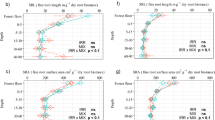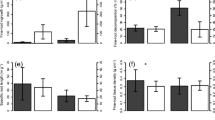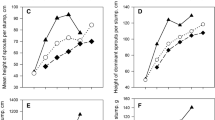Abstract
This study investigated the belowground development and strategy of late-successional European beech (Fagus sylvatica L.) in ageing natural Scots pine (Pinus sylvestris L.) and Silver birch (Betula pendula Roth.) woodlands in a French volcanic mid-elevation area. For this purpose root biomass, root profile and fine-root architecture of competitor trees were examined in 53 mixed pine–beech and 42 birch–beech woodlands along a stand maturation gradient, using the root auger technique (0–75-cm). The total beech fine-root biomass highly correlated with aerial dimensions such as stem height and girth, whereas it moderately correlated with its age, thus indicating the effects of competition. Basic stand biometric data such as stand density and basal area had no significant effect on beech root biomass. Conversely, competition indices taking into account the vertical dimensions of competitor trees were efficient, probably due to redundancy with beech height. At similar age and height, beeches under birch had a greater belowground development than beeches under pine. Each species exhibited specific rooting pattern and plasticity of fine-root architecture along the gradients of stand maturation and competition. Beech had a heart-shaped rooting habit in both mixings, which strongly increased along stand maturation. Its fine-root system adopted a foraging strategy to respond to increasing stand competition. The Scots pine fine-root system was plate-like and showed a low morphological plasticity, thus presumably a conservative strategy. Silver birch exhibited a high biomass and a foraging capacity in the topsoil but a loose root system in the subsoil. The coexistence of pine and beech roots in the upper soil presumably leads to a high belowground competition. Beech root system becomes predominant throughout the soil profile and it adopts an efficient foraging strategy, but at the expense of its belowground development. Conversely, the niche partitioning strategy between beech and birch may explain why beech develops strongly belowground in spite of the fact that birch has a dense rooting and a competitive fine-root architecture. As a consequence, beech mid-term regeneration and development may be facilitated under birch as compared with pine.
Similar content being viewed by others
References
Antos JA and Halpern CB 1997 Root system differences among species: implications for early successional changes in forests of Western Oregon. Am. Midl. Natur. 1, 97–108.
Bauhus J and Bartsch N 1996 Fine-root growth in beech (Fagus sylvatica) forest gaps. Can. J. For. Res. 26, 2153–2159.
Bauhus J and Messier C 1999 Soil exploitation strategies of fine roots in different tree species of the southern boreal forest of eastern Canada. Can. J. For. Res. 29, 260–273.
Bauhus J, Khanna PK and Menden N 2000 Aboveground and belowground interactions in mixed plantations of Eucalyptus globulus and Acacia mearnsii. Can. J. For. Res. 30, 1886–1894.
Bazzaz FA 1998 Plants in Changing Environment. Linking Physiological, Population, and Community Ecology. Cambridge University Press, Cambridge. 320 pp.
Berendse F 1979 Competition between plants with different rooting depths: I. Theoretical considerations. Oecologia 43, 19–26.
Berntson GM, Farnsworth EJ and Bazzaz FA 1995 Allocation, within and between organs, and the dynamics of root length changes in two birch species. Oecologia 101, 439–447.
Böhm W 1979 Methods of Studying Root Systems. Springer, Berlin. 188 p.
Brown AHF 1992 Functioning of mixed-species Stands at Gisburn NW England. In The Ecology of Mixed-Species Stands of Trees. Eds. Cannell, Malcolm and Robertson. pp. 125–150. Oxford Blackwell Publ., London.
Burch WH, Jones RH, Mou P and Mitchell RJ 1997 Root system development of single and mixed plant functional type com278 munities following harvest in a pine-hardwood forest. Can. J. For. Res. 27(11), 1753–1764.
Büttner V and Leuschner C 1994 Spatial and temporal patterns of root abundance in a mixed oak-beech forest. For. Ecol. Manage. 70, 11–21.
Caldwell MM and Richards JH 1986 Competing root systems: morphology and models of absorption. In On the Economy of Plant Form and Function. Ed. TJ Givnish. pp. 251–273. Cambridge Univ. Press, Cambridge.
Casper BB and Jackson RB 1997 Plant competition underground. Annu. Rev. Ecol. Syst. 28, 545–570.
Collet C, Lanter O and Pardos M 2001 Effects of canopy opening on height and diameter growth in naturally regenerated beech seedlings. Ann. For. Sci. 58, 127–134.
Connell J H and Slatyer R O 1977 Mechanisms of succession in natural communities and their role in community stability and organization. Am. Nat. 111, 1119–1144.
Crabtree RC and Berntson GM 1994 Root architectural responses of Betula lenta to spatially heterogeneous ammonium and nitrate. Plant Soil 158, 129–134.
Curt T and Prévosto B 2002 Root biomass and rooting profile of naturally regenerated beech in mid-elevation natural Scots pine woodlands. Plant Ecology (In press).
Esseinstat DM 1991 On the relationship between root length and the rate of root proliferation: a field study using citrus rootstocks. New Phytol. 188, 63–68.
Farrish K W 1991 Spatial and temporal fine-root distribution in three Louisiana forest soils. Soil Sci. Soc. Am. J. RR, 1752–1757.
Finér L, Messier C, and De Grandpré L 1997 Fine-root dynamics in mixed boreal conifer-broadleaf forest communities at different successional stages after fire. Can. J. For. Res. 27, 304–314.
Fitter AH 1994 Architecture and biomass allocation of components of the plastic response of root systems to soil heterogeneity. In Exploitation of Environmental Heterogeneity by Plants – Ecophysiological Processes Above-and Belowground. Eds. MM Caldwell and RW Pearcy. pp. 305–323. Academic Press, San Diego, CA.
Gale M R and Grigal DF 1987 Vertical distribution of northern tree species in relation to successional status. Can. J. For. Res. 17, 829–834.
Grier CC, Vogt KA Keyes MR and Edmonds RL 1981 Biomass distribution and above-and below-ground production in young and mature Abies amabilis zone ecosystems of the Washington Cascades. Can. J. For. Res. 11, 155–167.
Grime JP 1979 Plant Strategies and Vegetation Processes. J. Wiley and Sons, Chichester, UK.
Hendrick R L and Pregitzer K S 1993 The dynamics of fine root length, biomass, and nitrogen content in two northern hardwood ecosystems. Can. J. For. Res. 23, 2507–2520.
Hendricks CMA and Bianchi FJJA 1995 Root density and biomass in pure and mixed forest stands of Douglas-fir and Beech. Netherl. J. Agric. Sci. 43, 321–331.
Hynynen J 1993 Self-thinning models for even-aged stands of Pinus sylvestris, Picea abies and Betula pendula. Scand. J. For. Res. 8, 326–336.
Idol TW, Pope PE and Ponder F 2000 Fine root dynamics across a chronosequence of upland temperate deciduous forests. For. Ecol. Manage. 127, 153–167.
Jackson RB, Canadell J, Ehleringer JR, Mooney HA, Sala OE and Schulze ED 1996 A global analysis of root distribution for terrestrial biomes. Oecologia 108, 389–411.
Janssens I A, Sampson D A, Cermak J, Meiresonne L, Riguzzi F, Overloop S and Ceulemans R 1999 Above-and belowground phytomass and carbon storage in a Belgian Scots pine stand. Ann. For. Sci. 56, 81–90.
Kalisz PJ, Zimmerman RW and Muller RN 1987 Root density, abundance and distribution in the mixed mesophytic forest of Eastern Kentucky. Soil. Sci. Soc. Am. J. 51, 220–225.
Keyes MR and Grier CC 1981 Above-and below-ground net production in 40-years old Douglas-fir stands on low and high productivity sites. Can. J. For. Res. 11, 599–605.
Köstler J N, Bruchner E and Biebelriether H 1968 Die Wurzerln der Waldbaume. P. Parey, Hamburg. 284 p.
Le Goff N and Ottorini JM 2001 Root biomass and biomass increment in a beech (Fagus sylvatica L.) stand in the North-East France. Ann. For. Sci. 58, 1–13.
MacQueen DR 1968 The quantitative distribution of absorbing roots of Pinus sylvestris and Fagus sylvatica in a forest succession. Oecol. Plantar. 3, 83–99.
Makkonen K and Helmisaari HS 1998 Seasonal and yearly variations of fine-root biomass and necromass in a Scots pine (Pinus sylvestris L.) stand. For. Ecol. Manage. 102, 283–290.
Messier C and Nikinmaa E 2000 Effects of light availability and sapling size on the growth, biomass allocation, and crown morphology of understory sugar maple, yellow birch and beech. Ecoscience, 7(3), 345–356.
Nielsen CCN and Mackenthun G 1991 Die horizontale variation der feinwurzelaktivität in abhängigheit von der bestockungsdichte. AFJZ 162, 112.
Nilsson U and Albrektson A 1993 Productivity of needles and allocation of growth in young Scots pine trees of different competitive status. For. Ecol. Manage. 62, 173–187.
Palatova E and Mauer O 2001 Mutual relations of mountain ash, beech and spruce root systems in the mixed mountain forest. Ekologia 1, 79–91.
Parrish JAD and Bazzaz FA 1976 Underground niche separation in successional plants. Ecology 57, 1281–1288.
Perala DA and Alm AA 1990 Reproductive ecology of birch: a review. For. Ecol. Manage. 32, 1–38.
Persson H 1978 Root dynamics in a young Scots pine stand in central Sweden. Oïkos 30, 508–519.
Persson H 1983 The distribution and productivity of fine roots in boreal forests. Plant Soil 71, 87–101.
Polomski J and Kuhn N 1998 Wurzelsysteme. Verlag P. Haupt, Bern. 290 pp.
Poulson TL and Platt WJ 1996 Replacement patterns of beech and sugar maple in Warren Woods, Michigan. Ecology 77(4), 1234–1253.
Prévosto B, Curt T, Gueugnot J and Coquillard P 2000 Modeling mid-elevation Scots pine growth on a volcanic substrate. For. Ecol. Manage. 131, 223–237.
Prévosto B, Dambrine E, Moarès C, Curt T 2002. Soils and vegetation of naturally afforested woodlands according to volcanic ash chemistry and former agricultural use. Catena (in press).
Pritchett W L and Fisher R F 1987 Properties and Management of Forest Soils. J. Wiley, New York. 494 pp.
Pukkala T and Kolström T 1987 Competition indices and the prediction of radial growth in Scots pine. Silva Fenn. 21, 55–67.
Regent Instruments Inc., 2000 WinRhizoTM image analysis software V 5.0A. Regent Instruments Inc. 4040 rue Blain, Québec, G2B 5C3, Canada.
Roberts J 1976 A study of root distribution and growth in a Pinus sylvestris L. (Scots pine) plantation in East Anglia. Plant Soil, 44, 607–621.
Robinson D and Fitter A 1999 The magnitude and control of carbon transfer between plants linked by a common mycorrhizal network. J. Exp. Bot. 50, 9–13.
Rust S and Savill PS 2000 The root system of Fraxinus excelsior and Fagus sylvatica and their competitive relationships. Forestry 5, 499–508.
Safford LO 1974 Effect of fertilization on biomass and nutrient content of fine roots in a beech-birch-maple stand. Plant Soil 40, 349–363.
Santantonio D, Hermann RK and Overton WS 1977 Root biomass studies in forest ecosystems. Pedobiologia 17, 1–31.
Schmid I and Kazda M 2001 Vertical distribution and radial growth of coarse roots in pure and mixed stands of Fagus sylvatica and Picea abies. Can. J. For. Res. 31, 539–548.
Schmull M and Thomas FM 2000 Morphological and physiological reactions of young deciduous trees (Quercus robur L., Q. petraea [Matt.] Liebl., Fagus sylvatica L.) to waterlogging. Plant Soil 12, 227–242.
Strong WL and La Roi GH 1983 Rooting depths and successional development of selected boreal forest communities. Can. J. For. Res. 13, 577–588.
Sutton RF and Tinus RW 1983 Root and root system terminology. Forest. Sci. Monogr. 24, 137 pp.
Tomé M and Burkhart HE 1989 Distance-dependent competition measures for predicting growth of individual trees. For. Sci. 35, 816–831.
Vanninen P and Mäkelä A 1999 Fine root biomass of Scots pine stands differing in age and soil fertility in southern Finland. Tree Physiol. 19, 823–830.
Van Praag H J, Sougnez-Remy S, Weissen F and Carletti G 1988 Root turnover in a beech and a spruce stand in the Belgian Ardennes. Plant Soil, 105, 87–103.
Vogt K A, Vogt D J, Palmiotto P A, Boon P, O'Hara J and Asbjornsen H 1996 Review of root dynamics in forest ecosystems grouped by climate, climatic forest type and species. Plant Soil 187, 159–219.
Vogt K A, Vogt D J and Blommfield J 1999 Analysis of some direct and indirect methods for estimating root biomass and production of forests at an ecosystem level. Plant Soil 200, 71–89.
Wang JR, Letchford T, Comeau P and Kimmins JP 2000 Above-and belowground biomass and nutrient distribution of a paper birch and subalpine fir mixed-species stand in the sub-boreal spruce zone of British Columbia. For. Ecol. Manage. 130, 17–26.
Waring RH and Schlesinger WH 1985 Forest Ecosytems. Academic Press, New York. 340 pp.
Author information
Authors and Affiliations
Corresponding author
Rights and permissions
About this article
Cite this article
Curt, T., Prévosto, B. Rooting strategy of naturally regenerated beech in Silver birch and Scots pine woodlands. Plant and Soil 255, 265–279 (2003). https://doi.org/10.1023/A:1026132021506
Issue Date:
DOI: https://doi.org/10.1023/A:1026132021506




